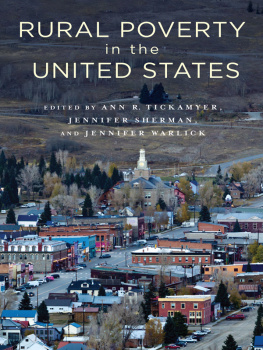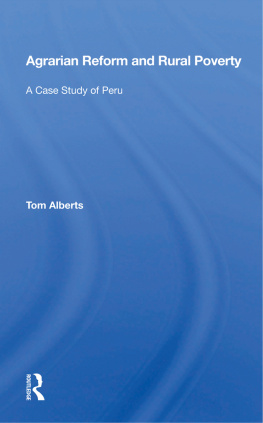Table of Contents
RURAL POVERTY IN THE UNITED STATES
RURAL POVERTY IN THE UNITED STATES
EDITED BY
Ann R. Tickamyer, Jennifer Sherman, and Jennifer Warlick
COLUMBIA UNIVERSITY PRESS
NEW YORK
Columbia University Press
Publishers Since 1893
New York Chichester, West Sussex
cup.columbia.edu
Copyright 2017 Columbia University Press
All rights reserved
E-ISBN 978-0-231-54471-9
Library of Congress Cataloging-in-Publication Data
Names: Tickamyer, Ann R., editor. | Sherman, Jennifer, editor. | Warlick, Jennifer L., editor.
Title: Rural poverty in the United States / [edited by] Ann Tickamyer, Jennifer Sherman, Jennifer Warlick.
Description: New York: Columbia University Press, [2017] | Includes bibliographical references and index.
Identifiers: LCCN 2017002248| ISBN 978-0-231-17222-6 (cloth: alk. paper) | ISBN 978-0-231-17223-3 (pbk.: alk. paper) | ISBN 978-0-231-54471-9 (e-book)
Subjects: LCSH: Rural poorUnited States. | PovertyUnited States.
Classification: LCC HC110.P6 R8925 2017 | DDC 339.4/60973091734dc23
LC record available at https://lccn.loc.gov/2017002248
A Columbia University Press E-book.
CUP would be pleased to hear about your reading experience with this e-book at .
Cover design: Julia Kushnirsky
Cover image: Pete Ryan / Getty Images
CONTENTS
Kenneth M. Johnson
Bruce Weber and Kathleen Miller
Leif Jensen and Danielle Ely
Ann R. Tickamyer and Emily J. Wornell
Kristin Smith
Lisa R. Pruitt
Mark H. Harvey
Rosalind P. Harris
Shannon M. Monnat and Raeven Faye Chandler
J. Celeste Lay
Jennifer Sherman
Jennifer Sherman
Brian Thiede and Tim Slack
Jill Ann Harrison
Alisha Coleman-Jensen and Barry Steffen
Sarah Whitley
Danielle Christine Rhubart and Elyzabeth W. Engle
Michael Hendryx
Catharine Biddle and Ian Mette
Kai A. Schafft
John M. Eason, L. Ash Smith, Jason Greenberg, Richard D. Abel, and Corey Sparks
Walter S. DeKeseredy and Amanda Hall-Sanchez
Jennifer Warlick
Gary Paul Green
Ann R. Tickamyer, Jennifer Sherman, and Jennifer Warlick
ANN R. TICKAMYER
This book has been a long time in the making, and I wish to thank the many contributors to its completion, including the coeditors whose collective knowledge, persistence, and debate greatly enriched this volume; Columbia University Press, especially Stephen Wesley, an enthusiastic, patient, and supportive editor, Joy Wilkie, who helped keep us organized, and others at the press who have assisted along the way; and above all, the authors whose stellar scholarship is at the heart of this volume.
In addition, I would like to thank the many collaborators, colleagues, and students over the years whose work has stimulated and deepened an ongoing interest in all forms of social inequality. I particularly want to remember my late dissertation advisor, Gerhard Lenski, whose influence continues to provide inspiration and to acknowledge the lasting impact of serving on the RSS Task Force on Persistent Poverty in Rural America that set the standard for this effort.
JENNIFER SHERMAN
I wish to thank the authors and coeditors, Columbia University Press, Stephen Wesley, and Joy Wilkie for all of their hard work in making this volume come together. I also thank the important rural scholars whose work continues to inspire me, and whose support has been invaluable to my career, including Conner Bailey, Louise Fortmann, Leif Jensen, Lisa Pruitt, Kai Schafft, Gene Summers, Ann Tickamyer, and Bruce Weber. I am extremely grateful for their contributions, both to this volume and to larger understandings of rural poverty in the United States and abroad.
JENNIFER WARLICK
I thank Stephen Wesley at Columbia University Press first and foremost for recognizing the need for a multidisciplinary text investigating poverty in rural America and for inviting me to participate in this endeavor. He also proved to be a patient, able collaborator and editor. Thanks also to the other members of CUPs editorial team, especially Joy Wilkie who cheerfully provided welcomed assistance that allowed us to focus on content rather than managerial details.
I am grateful to my coeditors for sharing their perspectives as sociologists and introducing me to many important scholars in their disciplinary field. My comprehension of familiar issues has been expanded and enriched as a result.
We would not have a text were it not for our contributors. They too broadened my perspectives and provoked me to think anew. I thank them for this, as well as for their contributions and patience during the editorial process.
I am also indebted to the undergraduate students in my rural poverty course at the University of Notre Dame whose questions and comments helped me understand what students generally want and need to learn about rural poverty in America. Their overall enthusiasm for this project kept me moving forward at critical junctures. One student in particular, Ash Smith, also provided valuable research assistance. Finally, I wish to thank David Betson at Notre Dame for his valuable insights and comments about my own chapter.
Rural Poverty in the United States treats rural poverty as a uniquely important subject and set of issues. We provide a broad and multifaceted overview of the causes, consequences, and forms of rural poverty in the United States. The scope and intensity of poverty experienced by rural people are often overlooked by the public, scholars, and policy makers, yet it persists as an enduring social problem. In this book we address serious conceptual and empirical issues that are distinctive to rural poverty and that make it unique when compared to other forms of U.S. poverty, including poverty in urban and suburban areas. We include authors from multiple disciplines, including sociology, demography, economics, law, political science, public health, and education. Together this multidisciplinary group of scholars describe, interrogate, and problematize rural poverty from a variety of angles and topics.
We move thematically from more general understandings of rural poverty and its roots, forms, and impacts, to discussions of measuring it and explaining its causes, to more in-depth explorations of specific aspects of rural poverty and its effects on and interactions with particular social groups and social institutions. This enables us to first set the context and introduce the reader to the main issues and concepts and to describe the scope and depth of the problem of rural poverty. After this introduction to the big picture of rural poverty, we move on to in-depth explorations of the populations affected by rural poverty, the social structures that keep it in place, and the processes that reproduce it. We conclude by discussing possible solutions to rural poverty and its impacts and provide an understanding of the complexities inherent in addressing rural poverty from economic and policy perspectives.
then puts rural poverty in historical context, explaining both the variation in rural poverty rates over time and its concentration and persistence. In this section we familiarize the reader with the poor populations of rural America and the types of rural American communities where poverty is concentrated, providing an overview of who the poor are and where poverty is found in rural areas of the United States.







